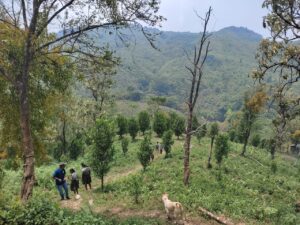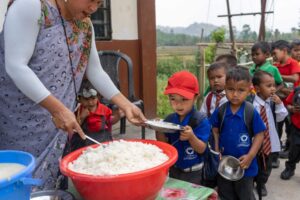As we approach the 50 years of our statehood it is important to reflect on the good and bad of the journey towards this milestone. A good way of doing that is to assess the achievements or regression that has happened among some crucial indicators of development. An important concept in this regard is the Sustainable Development Goals (SDGs) which were adopted by the United Nations in 2015 as a universal call to action to end poverty, protect the planet, and ensure that by 2030 all people enjoy peace and prosperity. India is tracking its progress towards the 17 Goals that have been identified under this framework. The 2021 NITI Aayog Report “North Eastern Region: District SDG Index and Dashboard: Baseline Report 2021-2022” was a part of this process with the focus being on North East India. Meghalaya did very badly in the overall ranking coming second from the bottom. Among the specific targets the performance under SDG 2 – Zero Hunger was very disappointing.
SDG 2 aims to end all forms of hunger and malnutrition by 2030, making sure all people – especially children – have sufficient and nutritious food all year. The NITI Aayog report revealed that the highest ranked district from Meghalaya under this goal is South West Garo Hills which came in the 42nd rank among all the districts in the North East. The indicators in which the State has performed badly are percentage of children under 5 who are stunted (around or more than 30% in all districts), percentage of children who are underweight (from almost 20% to more than 30%), percentage of pregnant women 15-49 who are anaemic – >11.0 g/dl (from almost 30% to more than 60%), and percentage of children aged 6-59 months – >11.0 g/dl (again from almost 30% to more than 60%). To summarise, Meghalaya suffers from various forms of malnutrition, including the pandemic of ‘hidden hunger’ or malnutrition deficiency. Children as seen from the figures given above, are especially very vulnerable.
The problem of malnutrition was a special concern which prompted NESFAS to implement the Rural Electrification Corporation (REC) supported project “No One Shall be Left Behind Initiative: Biodiversity for Food, Nutrition and Energy Security, Meghalaya and Nagaland”. Among the interventions, supplementation of MDM (Mid-Day Meal) program through establishment of School Gardens was an important initiative. Under this School Gardens were established in more than 40 schools engaging almost 200 school children. The idea is to support the existing MDM program for improving dietary diversity, i.e., increasing the number of food groups consumed by school children.
MDM is a flagship program of the Govt. which caters to the supplementary nutritional needs of school going children. Mid-Day Meal Scheme was introduced in the State of Meghalaya since 1995. From 2004-2005 onwards and as per Supreme Court Order cooked meal is provided to all Govt. and Govt. aided Lower Primary and Upper Primary Schools for 10 academic months. Food grains is provided free of cost through Food Corporation of India (FCI) by Government of India. The transportation cost of rice calculated as per PDS (Public Distribution System) Rate of the State and is met by Government of India. For the other ingredients which includes oil, dal, condiment and other vegetables the respective school have to purchase from the funds that have been allocated for the purpose from the open market. The program is a highly commendable one but some problems were detected regarding its implementation during discussion with communities working with NESFAS.
Green leafy vegetables are absent from the diet in many schools. This deprives the children of important micro-nutrients, particularly iron. Potato is a common item in the diet and considered a vegetable when in fact it is a starchy staple. Rice is already available as the starchy staple and this duplication of food group is a waste of financial resources which is already inadequate (a little later on that). Also, in many schools dal is cooked and given to children along with nutrela or horse gram. All the three are pulses and a good source of plant protein. Giving just one of them would have sufficed. The financial resources saved could then be used for buying other vegetables. But even for rice that is supplied free of cost it suffers from many problems. Irregularity in the supply of rice is a common problem. Recently during a review undertaken in one of the schools it was reported that they were supplied with plastic rice. A complaint was filed but no action was taken forcing the school to use its own funds to buy new stock of rice. The schools also shared that the amount allocated for purchase of other food items is woefully inadequate and the school has to dip into its own funds to cover the shortfall. Many a times the schools have to buy all the ingredients from their own fund which they can get reimburse after submitting the bills. This however takes a lot of time, ranging from months to a year. The rate of honorarium to Cook-Cum-Helpers is Rs. 1000/- per month (900Central Share + 100 State Share) for ten months is well below minimum wage. Because of these shortcomings the functioning of the Mid-Day Meal has not been satisfactory.
While NESFAS does not have the mandate to solve institutional problems like funding and salary it decided to focus on the nutritional aspect. School gardens were established to grow food plants which were missing from the diet, e.g., green leafy vegetables, vitamin A rich food plants among others. In the second half 2021 NESFAS did an assessment to find out if any improvement has taken place in the dietary pattern of the school children. For this study 32 schools from different parts of Meghalaya were selected. The variable used for assessment is DDS i.e., Dietary Diversity Score.
DDS is measured by the number of different food groups consumed over a period of 24 hours, and the score is a validated proxy indicator of dietary adequacy, i.e., micronutrient adequacy. A food group is defined as a group of food items that have similar caloric and nutrient contents. The principle of DDS is based on the fact that different foods are sources of different macro and micronutrients, so a diverse diet best ensures nutrient adequacy. There are 10 standard food groups and a score of DDS 5 (consumption of at least 5 five groups) is considered to be the benchmark for a nutritionally adequate diet.
The assessment found that the overall average DDS from existing MDM program is 3.28, well below the benchmark. Only Little Flower, RCLP School Mawmuthoh (Mawryngkneng Block) had a score of more than DDS 5. With the establishment of the school gardens the overall average DDS rose to 6.28. The highest DDS was recorded from RCLP/RCUP School Laitsohpliah and RCLP School Nongtraw (both from KhatarshnongLaitkroh Block) with DDS 9 and DDS 8 respectively. On an average, the school gardens contributed around 3 new food groups to the diet. These were Green Leafy Vegetables (like mustard leaves, taro leaves, cabbage, lettuce along with wild edibles like khliangsyiar, jamyrdoh, jail, jaiing etc), Vitamin A Rich Food Plants (pumpkin, carrot, tree tomato etc) and Other Vegetables (bottle gourd, brinjal, turnip, radish etc). Nuts and Seeds and Other Fruits were also the food groups that were added in some schools. The establishment of school gardens has, thus, helped in tackling the problem of ‘hidden hunger’ among the school children who were part of the program.
The establishment of a School Garden to supplement MDM is a cost-effective method which if done properly (knowledge of the FAO 10 Food Groups) has the potential to tackle the problem of malnutrition especially ‘hidden hunger’ among school children in Meghalaya. This will go a long way in improving the performance of the State as regards SDG 2. With the Goals interlinked this will then have a multiplier effect which will ultimately raise the overall rank of the State. Helping our children access nutritious food and inculcate healthy food habits is, however, more important that any ranking and should be a priority.


